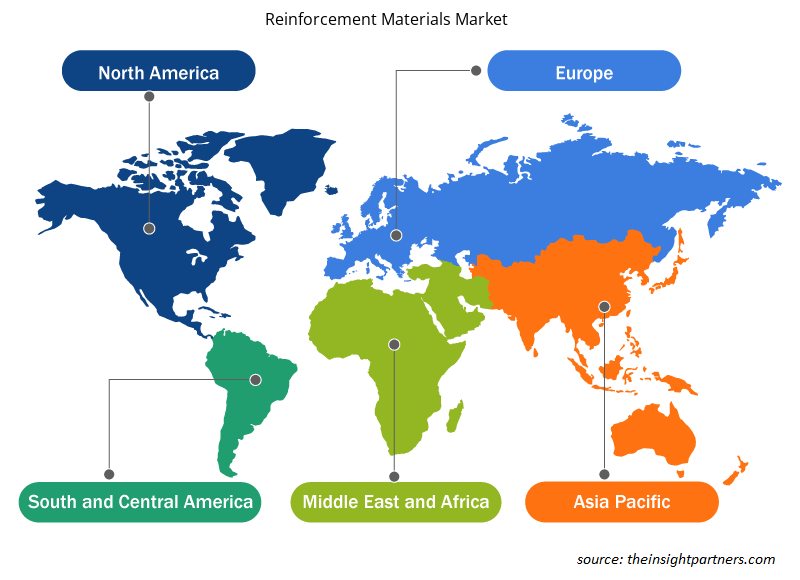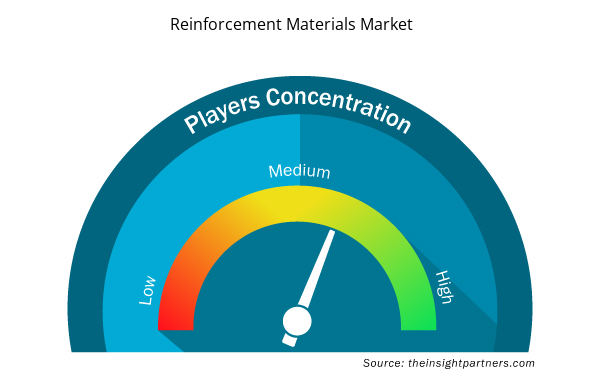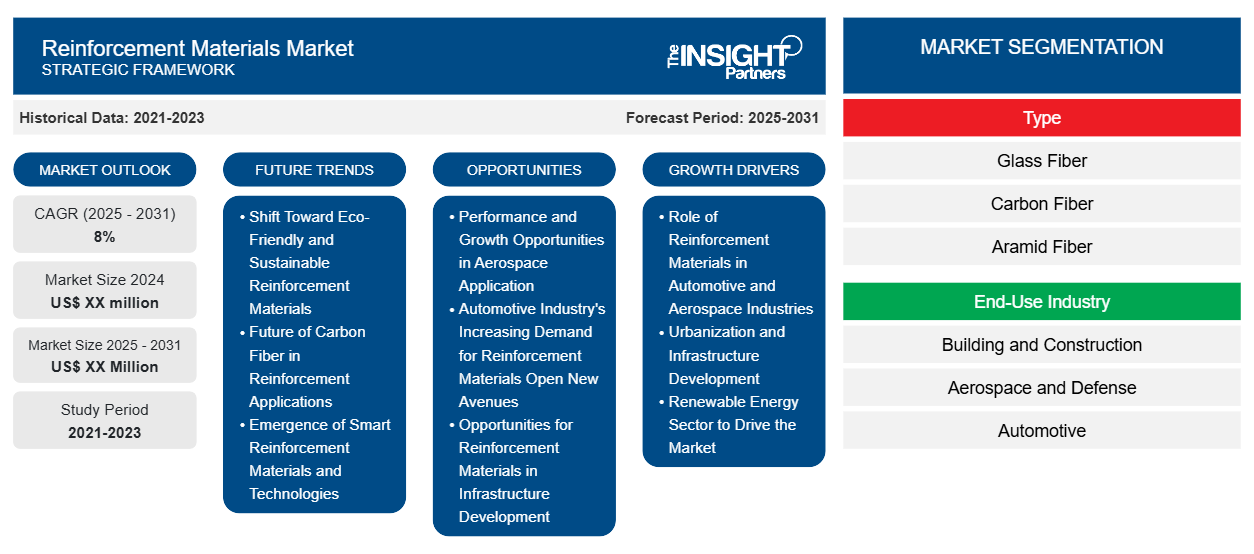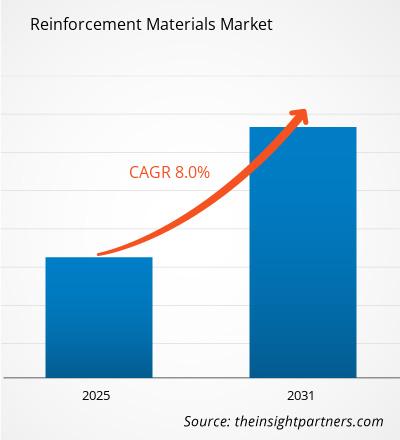Le marché des matériaux de renforcement devrait enregistrer un TCAC de 8 % de 2023 à 2031, avec une taille de marché passant de XX millions USD en 2023 à XX millions USD d'ici 2031.
Le rapport sur le marché des matériaux de renforcement est segmenté par type (fibre de verre, fibre de carbone, fibre d'aramide , fibre naturelle, barres d'armature en acier et autres). Le marché est segmenté en fonction de l'industrie d'utilisation finale (bâtiment et construction, aérospatiale et défense, automobile, énergie éolienne, électronique grand public, marine, articles de sport et autres). La taille du marché et les prévisions aux niveaux mondial, régional et national pour tous les segments de marché clés sont couvertes dans le cadre du périmètre. Le rapport offre la valeur en USD pour l'analyse, les segments, les régions et les pays ci-dessus. Le rapport couvre les tendances du marché, ainsi que la dynamique du marché telle que les moteurs, les contraintes et les opportunités clés. Le rapport couvre également le paysage industriel et l'analyse de la concurrence couvrant la concentration du marché, l'analyse de la carte thermique, les principaux acteurs et les développements récents du marché.
Objectif du rapport
Le rapport sur le marché des matériaux de renforcement de The Insight Partners vise à décrire le paysage actuel et la croissance future, les principaux facteurs moteurs, les défis et les opportunités. Cela fournira des informations à diverses parties prenantes commerciales, telles que :
- Fournisseurs/fabricants de technologie : pour comprendre l’évolution de la dynamique du marché et connaître les opportunités de croissance potentielles, leur permettant de prendre des décisions stratégiques éclairées.
- Investisseurs : Effectuer une analyse complète des tendances concernant le taux de croissance du marché, les projections financières du marché et les opportunités qui existent tout au long de la chaîne de valeur.
- Organismes de réglementation : Réglementer les politiques et surveiller les activités du marché dans le but de minimiser les abus, de préserver la confiance des investisseurs et de maintenir l’intégrité et la stabilité du marché.
Segmentation du marché des matériaux de renforcement
Taper
- Fibre de verre
- Fibre de carbone
- Fibre d'aramide
- Fibres naturelles
- Barres d'armature en acier
- Autres
Secteur d'utilisation finale
- Bâtiment et construction
- Aérospatiale et Défense
- Automobile
- Énergie éolienne
- Électronique grand public
- Marin
- Articles de sport
- Autres
Personnalisez ce rapport en fonction de vos besoins
Vous bénéficierez d'une personnalisation gratuite de n'importe quel rapport, y compris de certaines parties de ce rapport, d'une analyse au niveau des pays, d'un pack de données Excel, ainsi que de superbes offres et réductions pour les start-ups et les universités.
- Obtenez les principales tendances clés du marché de ce rapport.Cet échantillon GRATUIT comprendra une analyse de données, allant des tendances du marché aux estimations et prévisions.
Facteurs de croissance du marché des matériaux de renforcement
- Rôle des matériaux de renforcement dans les industries automobile et aérospatiale : Le besoin croissant de matériaux légers et à haute résistance est l'un des principaux moteurs du marché des matériaux de renforcement à l'échelle mondiale. La demande accrue provient principalement des industries automobile et aérospatiale, où leurs fabricants intègrent la réduction du poids des véhicules et des avions comme mesures pour améliorer l'efficacité énergétique et les performances. Les matériaux de renforcement tels que la fibre de carbone et la fibre de verre joueraient un rôle déterminant dans ces objectifs en raison de leur rapport résistance/poids élevé. Les réglementations plus strictes en matière d'efficacité énergétique ainsi que les réglementations sur les émissions font que les matériaux de renforcement sont les plus utilisés dans les industries pour produire des composants à haute résistance mais à faible poids.
- Urbanisation et développement des infrastructures : L'urbanisation généraliserait donc une tendance vers des matériaux performants et durables pour les bâtiments et autres infrastructures, comme les ponts ou les routes. Le marché des matériaux de renforcement est principalement porté par la construction des pays en développement. Le développement et la croissance des villes signifient une demande accrue de matériaux de construction civile et de bâtiment plus résistants, plus durables et plus performants. Les matériaux de renforcement comprennent les barres d'armature en acier, les composites en fibre de carbone et les fibres synthétiques et sont largement utilisés comme renforts avec le béton pour supporter de lourdes charges ainsi que pour résister aux conditions climatiques difficiles. À l'avenir, on s'attend à ce que l'application de matériaux de renforcement, axée sur la construction de la résilience et de la longévité, ne diminue pas.
- Le secteur des énergies renouvelables va stimuler le marché : Les nouveaux développements dans le secteur des énergies renouvelables, en particulier avec les progrès de l'énergie éolienne, créent de très bonnes conditions grâce auxquelles les matériaux de renforcement peuvent contribuer de manière significative à l'amélioration des performances des éoliennes. Les matériaux composites renforcés de fibres de verre et de fibres de carbone sont importants dans les pales d'éoliennes et d'autres composants critiques pour leur durabilité, leurs propriétés de légèreté et leur résistance aux contraintes environnementales. Plus les gouvernements et les entreprises investissent dans ces sources d'énergie renouvelables, plus la part du marché massif qui nécessite des matériaux de renforcement augmentera dans ce secteur
Tendances futures du marché des matériaux de renforcement
- Vers des matériaux de renforcement écologiques et durables : À l’heure actuelle, le marché des matériaux de renforcement connaît une rupture progressive, qui s’oriente vers des matériaux écologiques d’un côté et vers des matériaux durables de l’autre. Les fabricants développent désormais des matériaux de renforcement plus écologiques, recyclables ou fabriqués à partir de sources renouvelables. Les biocomposites associent des fibres naturelles et des résines biosourcées et sont désormais adaptés aux secteurs de la construction et de l’automobile comme une alternative beaucoup plus écologique aux matériaux de renforcement traditionnels. L’émergence de nouveaux principes d’économie circulaire pourrait faciliter plus rapidement l’innovation dans ces matériaux.
- L'avenir de la fibre de carbone dans les applications de renforcement : La fibre de carbone reste le matériau de choix en matière de renforcement en raison de son rapport résistance/poids et de son excellente résistance à la fatigue. À l'avenir, les progrès dans la technologie de production de fibre de carbone devraient réduire considérablement les coûts et améliorer les performances de la production de fibre de carbone, facilitant ainsi l'utilisation de ce matériau dans différentes industries. Par exemple, les fibres de carbone continues et le développement de composites hybrides élargiraient les horizons des fibres de carbone dans les applications futures concernant l'industrie automobile, l'aéronautique et les équipements sportifs.
- Émergence de matériaux et technologies de renforcement intelligents : les matériaux de renforcement intelligents sont l’une de ces méthodes qui pourraient être si innovantes pour intégrer des technologies intelligentes dans les matériaux de renforcement. Les matériaux intelligents sont capables de détecter et de réagir aux changements de température, de pression ou de conditions de contrainte qui les entourent. Les composites auto-réparateurs, par exemple, sont ceux qui peuvent réparer les dommages causés par des perturbations ou des dommages. Ils amélioreront la durabilité et la sécurité des structures. De plus, les renforts dotés de capteurs seraient capables de fournir des données de mise à jour de santé en temps réel qui pourraient même bénéficier de l’apprentissage des infrastructures vraiment massives telles que les ponts et les immeubles à plusieurs étages. Ces futurs matériaux de renforcement avancés ne pourront qu’être améliorés par des matériaux plus intelligents, qui permettront des avancées de surveillance véritablement de niveau IoT.
Opportunités de marché pour les matériaux de renforcement
- Opportunités de performance et de croissance dans les applications aérospatiales : les performances, la sécurité et l'économie de carburant ont généralement placé les industries aérospatiales parmi les autres marchés optimistes pour les matériaux de renforcement. Le développement de composants d'aéronefs hautement performants, tels que les ailes, les fuselages et les pièces intérieures, intègre de plus en plus des composites avancés renforcés par des fibres de carbone et d'autres matériaux à haute résistance. Il s'agira d'une énorme opportunité pour les fournisseurs de matériaux de renforcement du secteur aérospatial, car l'augmentation du transport aérien et la demande d'avions de nouvelle génération continuent de croître.
- La demande croissante de matériaux de renforcement de l'industrie automobile ouvre de nouvelles perspectives : L'industrie automobile apparaît comme le marché le plus important pour les matériaux de renforcement. La demande croissante de véhicules légers qui amélioreront les économies de carburant et réduiront les émissions de carbone entraînera une augmentation de l'application de leurs matériaux de renforcement tels que la fibre de carbone et la fibre de verre pour la fabrication de panneaux de carrosserie, de châssis et de composants intérieurs. Le potentiel de marché des matériaux de renforcement se multiplie étant donné que l'avenir exige de plus en plus de véhicules électriques qui ont besoin de poids légers pour des batteries plus efficaces et une autonomie plus importante.
- Opportunités pour les matériaux de renforcement dans le développement des infrastructures : Le développement des infrastructures dans les économies émergentes, en particulier en Asie-Pacifique, en Afrique et en Amérique latine, offre d'énormes possibilités pour le marché des matériaux de renforcement. L'urbanisation croissante des pays entraîne une demande de développement de matériaux de construction durables et résistants. Les gouvernements offrent la plupart des investissements dans les routes, les ponts et les bâtiments publics, ce qui nécessite des renforts utilisés pour la durée de vie et l'intégrité structurelle. En outre, le besoin accru de structures sismiques dans les zones sujettes aux tremblements de terre offre de nombreuses opportunités de croissance future des matériaux de renforcement tels que les polymères renforcés de fibres de carbone et les fibres d'acier.
Aperçu régional du marché des matériaux de renforcement
Les tendances régionales et les facteurs influençant le marché des matériaux de renforcement tout au long de la période de prévision ont été expliqués en détail par les analystes d’Insight Partners. Cette section traite également des segments et de la géographie du marché des matériaux de renforcement en Amérique du Nord, en Europe, en Asie-Pacifique, au Moyen-Orient et en Afrique, ainsi qu’en Amérique du Sud et en Amérique centrale.

- Obtenez les données régionales spécifiques au marché des matériaux de renforcement
Portée du rapport sur le marché des matériaux de renforcement
| Attribut de rapport | Détails |
|---|---|
| Taille du marché en 2023 | XX millions de dollars américains |
| Taille du marché d'ici 2031 | XX millions de dollars américains |
| Taux de croissance annuel composé mondial (2023-2031) | 8% |
| Données historiques | 2021-2022 |
| Période de prévision | 2024-2031 |
| Segments couverts | Par type
|
| Régions et pays couverts | Amérique du Nord
|
| Leaders du marché et profils d'entreprises clés |
|
Densité des acteurs du marché des matériaux de renforcement : comprendre son impact sur la dynamique commerciale
Le marché des matériaux de renforcement connaît une croissance rapide, tirée par la demande croissante des utilisateurs finaux en raison de facteurs tels que l'évolution des préférences des consommateurs, les avancées technologiques et une plus grande sensibilisation aux avantages du produit. À mesure que la demande augmente, les entreprises élargissent leurs offres, innovent pour répondre aux besoins des consommateurs et capitalisent sur les tendances émergentes, ce qui alimente davantage la croissance du marché.
La densité des acteurs du marché fait référence à la répartition des entreprises ou des sociétés opérant sur un marché ou un secteur particulier. Elle indique le nombre de concurrents (acteurs du marché) présents sur un marché donné par rapport à sa taille ou à sa valeur marchande totale.
Les principales entreprises opérant sur le marché des matériaux de renforcement sont :
- 3B - l'entreprise de fibre de verre
- BASF SE SE
- DuPont
- Honeywell International Inc.
- Groupe JEC Group
Avis de non-responsabilité : les sociétés répertoriées ci-dessus ne sont pas classées dans un ordre particulier.

- Obtenez un aperçu des principaux acteurs du marché des matériaux de renforcement
Principaux arguments de vente
- Couverture complète : Le rapport couvre de manière exhaustive l’analyse des produits, des services, des types et des utilisateurs finaux du marché des matériaux de renforcement, offrant un paysage holistique.
- Analyse d’experts : Le rapport est compilé sur la base d’une compréhension approfondie des experts et analystes du secteur.
- Informations à jour : Le rapport garantit la pertinence commerciale en raison de sa couverture des informations récentes et des tendances des données.
- Options de personnalisation : ce rapport peut être personnalisé pour répondre aux exigences spécifiques du client et s'adapter parfaitement aux stratégies commerciales.
Le rapport de recherche sur le marché des matériaux de renforcement peut donc aider à ouvrir la voie au décodage et à la compréhension du scénario de l’industrie et des perspectives de croissance. Bien qu’il puisse y avoir quelques préoccupations valables, les avantages globaux de ce rapport ont tendance à l’emporter sur les inconvénients.
- Analyse historique (2 ans), année de base, prévision (7 ans) avec TCAC
- Analyse PEST et SWO
- Taille du marché Valeur / Volume - Mondial, Régional, Pays
- Industrie et paysage concurrentiel
- Ensemble de données Excel



Report Coverage
Revenue forecast, Company Analysis, Industry landscape, Growth factors, and Trends

Segment Covered
This text is related
to segments covered.

Regional Scope
North America, Europe, Asia Pacific, Middle East & Africa, South & Central America

Country Scope
This text is related
to country scope.
Questions fréquemment posées
Based on geography, Asia Pacific held the largest share of the reinforcement materials market due to the strong growth of the automotive and industrial sector in the region.
Sustainability and green reinforcement materials are expected to be the key market trends.
Based on end-use industry, the wind energy segment is expected to witness the fastest growth during the forecast period.
The Reinforcement Materials Market is estimated to witness a CAGR of 8% from 2023 to 2031
Increased demand for lightweight and high-strength materials are driving the market growth.
TORAY INDUSTRIES INC, BASF SE, DuPont de Nemours Inc, TEIJIN LIMITED, Owens Corning, Solvay SA, SGL Carbon SE, Hyosung Corporation, 3B-The Fiberglass Company, and Mitsubishi Chemical Corporation are the key players operating in the reinforcement materials market.
Trends and growth analysis reports related to Chemicals and Materials : READ MORE..
The List of Companies
- 3B - the fiberglass company
- BASF SE
- DuPont
- Honeywell International Inc.
- JEC Group
- NJR Steel
- Owens Corning
- Solvay
- TEIJIN LIMITED
- TORAY INDUSTRIES, INC.
The Insight Partners performs research in 4 major stages: Data Collection & Secondary Research, Primary Research, Data Analysis and Data Triangulation & Final Review.
- Data Collection and Secondary Research:
As a market research and consulting firm operating from a decade, we have published and advised several client across the globe. First step for any study will start with an assessment of currently available data and insights from existing reports. Further, historical and current market information is collected from Investor Presentations, Annual Reports, SEC Filings, etc., and other information related to company’s performance and market positioning are gathered from Paid Databases (Factiva, Hoovers, and Reuters) and various other publications available in public domain.
Several associations trade associates, technical forums, institutes, societies and organization are accessed to gain technical as well as market related insights through their publications such as research papers, blogs and press releases related to the studies are referred to get cues about the market. Further, white papers, journals, magazines, and other news articles published in last 3 years are scrutinized and analyzed to understand the current market trends.
- Primary Research:
The primarily interview analysis comprise of data obtained from industry participants interview and answers to survey questions gathered by in-house primary team.
For primary research, interviews are conducted with industry experts/CEOs/Marketing Managers/VPs/Subject Matter Experts from both demand and supply side to get a 360-degree view of the market. The primary team conducts several interviews based on the complexity of the markets to understand the various market trends and dynamics which makes research more credible and precise.
A typical research interview fulfils the following functions:
- Provides first-hand information on the market size, market trends, growth trends, competitive landscape, and outlook
- Validates and strengthens in-house secondary research findings
- Develops the analysis team’s expertise and market understanding
Primary research involves email interactions and telephone interviews for each market, category, segment, and sub-segment across geographies. The participants who typically take part in such a process include, but are not limited to:
- Industry participants: VPs, business development managers, market intelligence managers and national sales managers
- Outside experts: Valuation experts, research analysts and key opinion leaders specializing in the electronics and semiconductor industry.
Below is the breakup of our primary respondents by company, designation, and region:

Once we receive the confirmation from primary research sources or primary respondents, we finalize the base year market estimation and forecast the data as per the macroeconomic and microeconomic factors assessed during data collection.
- Data Analysis:
Once data is validated through both secondary as well as primary respondents, we finalize the market estimations by hypothesis formulation and factor analysis at regional and country level.
- Macro-Economic Factor Analysis:
We analyse macroeconomic indicators such the gross domestic product (GDP), increase in the demand for goods and services across industries, technological advancement, regional economic growth, governmental policies, the influence of COVID-19, PEST analysis, and other aspects. This analysis aids in setting benchmarks for various nations/regions and approximating market splits. Additionally, the general trend of the aforementioned components aid in determining the market's development possibilities.
- Country Level Data:
Various factors that are especially aligned to the country are taken into account to determine the market size for a certain area and country, including the presence of vendors, such as headquarters and offices, the country's GDP, demand patterns, and industry growth. To comprehend the market dynamics for the nation, a number of growth variables, inhibitors, application areas, and current market trends are researched. The aforementioned elements aid in determining the country's overall market's growth potential.
- Company Profile:
The “Table of Contents” is formulated by listing and analyzing more than 25 - 30 companies operating in the market ecosystem across geographies. However, we profile only 10 companies as a standard practice in our syndicate reports. These 10 companies comprise leading, emerging, and regional players. Nonetheless, our analysis is not restricted to the 10 listed companies, we also analyze other companies present in the market to develop a holistic view and understand the prevailing trends. The “Company Profiles” section in the report covers key facts, business description, products & services, financial information, SWOT analysis, and key developments. The financial information presented is extracted from the annual reports and official documents of the publicly listed companies. Upon collecting the information for the sections of respective companies, we verify them via various primary sources and then compile the data in respective company profiles. The company level information helps us in deriving the base number as well as in forecasting the market size.
- Developing Base Number:
Aggregation of sales statistics (2020-2022) and macro-economic factor, and other secondary and primary research insights are utilized to arrive at base number and related market shares for 2022. The data gaps are identified in this step and relevant market data is analyzed, collected from paid primary interviews or databases. On finalizing the base year market size, forecasts are developed on the basis of macro-economic, industry and market growth factors and company level analysis.
- Data Triangulation and Final Review:
The market findings and base year market size calculations are validated from supply as well as demand side. Demand side validations are based on macro-economic factor analysis and benchmarks for respective regions and countries. In case of supply side validations, revenues of major companies are estimated (in case not available) based on industry benchmark, approximate number of employees, product portfolio, and primary interviews revenues are gathered. Further revenue from target product/service segment is assessed to avoid overshooting of market statistics. In case of heavy deviations between supply and demand side values, all thes steps are repeated to achieve synchronization.
We follow an iterative model, wherein we share our research findings with Subject Matter Experts (SME’s) and Key Opinion Leaders (KOLs) until consensus view of the market is not formulated – this model negates any drastic deviation in the opinions of experts. Only validated and universally acceptable research findings are quoted in our reports.
We have important check points that we use to validate our research findings – which we call – data triangulation, where we validate the information, we generate from secondary sources with primary interviews and then we re-validate with our internal data bases and Subject matter experts. This comprehensive model enables us to deliver high quality, reliable data in shortest possible time.


 Obtenez un échantillon gratuit pour ce rapport
Obtenez un échantillon gratuit pour ce rapport